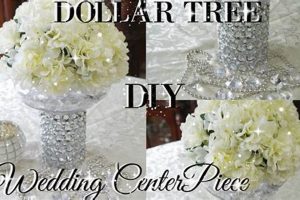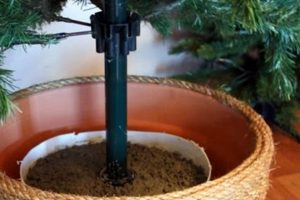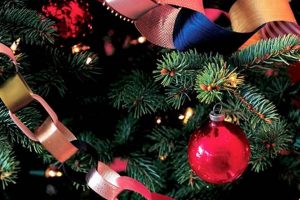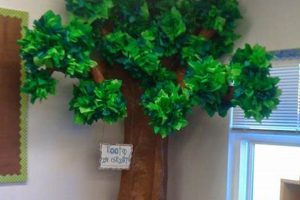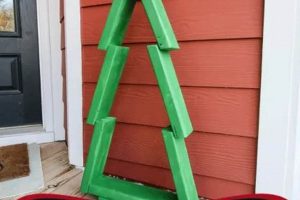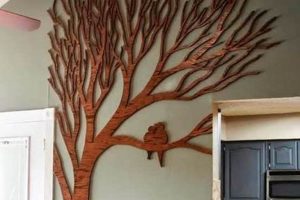A holiday decoration project involves the construction of an evergreen-shaped ornamental piece using polyvinyl chloride (PVC) piping and employing do-it-yourself (DIY) methods. This undertaking merges resourcefulness with festive creativity to produce a unique and often personalized Christmas tree alternative. For example, individuals may choose to build a small, tabletop version or a life-sized display for their home or yard.
The appeal of creating such a display stems from several factors including cost-effectiveness, customization possibilities, and the potential for reuse. PVC piping is generally less expensive than purchasing a natural tree or a pre-made artificial one. Furthermore, the construction process allows for complete control over the tree’s size, shape, and aesthetic. The resulting structure is durable and can be easily stored for subsequent holiday seasons. Historically, the rise in popularity of DIY projects and the increasing accessibility of online tutorials have contributed to the widespread adoption of this construction technique.
The following sections will delve into specific material requirements, step-by-step assembly instructions, and various design embellishments applicable to the creation of a holiday display using PVC.
Construction Insights
This section provides key recommendations to optimize the creation of a holiday tree alternative using PVC materials. Careful consideration of these insights will enhance structural integrity and aesthetic appeal.
Tip 1: Material Selection: Utilize Schedule 40 PVC pipe for its robust nature. This grade ensures the structure can withstand seasonal use and resist warping.
Tip 2: Precise Cutting: Employ a pipe cutter or saw to ensure clean, perpendicular cuts. Accurate measurements are crucial for symmetrical branch placement and overall tree form.
Tip 3: Secure Connections: Utilize PVC cement specifically designed for bonding PVC. Allow adequate curing time as specified by the manufacturer before assembling subsequent sections.
Tip 4: Branch Angle Considerations: When attaching branches, consider angling them slightly upwards. This simulates the natural growth pattern of evergreen trees and enhances visual realism.
Tip 5: Weight Distribution: For larger structures, implement a weighted base to prevent tipping. Sand or gravel can be added inside the base pipe to increase stability.
Tip 6: Concealed Wiring: If incorporating electrical lighting, plan for internal wire routing within the PVC frame. This minimizes exposed wires and creates a cleaner aesthetic.
Tip 7: Surface Preparation: Prior to painting or decorating, thoroughly clean the PVC surface with a degreaser. This improves paint adhesion and prevents discoloration.
Implementing these recommendations will result in a durable, aesthetically pleasing, and structurally sound holiday tree alternative. Careful attention to detail during construction ensures longevity and enjoyment for many seasons.
The following section will explore the environmental considerations of utilizing PVC in this application, alongside suggestions for sustainable practices.
1. Material Durability
Material durability is a paramount consideration in the construction of a polyvinyl chloride holiday display, dictating the lifespan and resilience of the finished product. The selection of appropriate materials directly influences the ability of the structure to withstand environmental factors and physical stresses associated with repeated use and storage. Therefore, a thorough understanding of material properties is essential for a successful outcome.
- PVC Grade and Thickness
The grade and thickness of the PVC pipe significantly impact its load-bearing capacity and resistance to bending or breakage. Schedule 40 PVC, a common choice, offers a balance between strength and cost. Thinner-walled pipes may be suitable for purely decorative elements, but thicker grades are recommended for structural components supporting significant weight. Selecting the appropriate schedule ensures the holiday display maintains its form and integrity over time.
- Joint Adhesion
The method and quality of joint adhesion play a crucial role in the overall durability. Utilizing appropriate PVC cement and adhering to recommended curing times are essential for creating strong, permanent bonds. Inadequate adhesion can lead to joint failure under stress, compromising the stability of the entire structure. Regular inspection of joints is advised to identify and address any signs of weakening.
- Environmental Resistance
PVC’s inherent resistance to moisture and rot contributes to its suitability for both indoor and outdoor holiday decorations. However, prolonged exposure to ultraviolet (UV) radiation can cause degradation, leading to discoloration and embrittlement. Incorporating UV-resistant coatings or storing the display indoors during off-seasons can mitigate these effects and prolong the material’s lifespan.
- Impact Resistance
While PVC is generally durable, it is susceptible to impact damage, particularly in cold temperatures. Careful handling during assembly and storage is necessary to prevent cracks or fractures. Reinforcing vulnerable areas, such as the base or branch connections, can enhance impact resistance and minimize the risk of accidental damage.
The preceding facets illustrate the direct link between material durability and the success of a polyvinyl chloride holiday display. Choosing appropriate grades of PVC, ensuring robust joint adhesion, mitigating environmental degradation, and minimizing impact damage are all critical steps in creating a durable and long-lasting holiday decoration. Attention to these details ensures that the finished product provides festive cheer for years to come.
2. Structural Integrity
Structural integrity is paramount to the success and longevity of any polyvinyl chloride holiday tree construction. A failure to adequately address structural considerations during the design and assembly phases can result in collapse, instability, or premature degradation of the artistic structure. The relationship between sound structural design and a successful result is one of direct causation: robust construction techniques yield a durable and aesthetically pleasing display, while weak or improperly executed connections lead to potential hazards and a diminished lifespan. This concept holds particular significance given the inherent weight distribution challenges associated with a tree-like form fabricated from linear materials. A lack of structural integrity undermines the purpose and value of the project.
For example, consider a life-size display assembled with insufficient bracing or inadequately cemented joints. The cumulative weight of the branches, especially when adorned with decorations, creates significant stress on the central support. Over time, these stresses can cause joint separation or pipe bending, leading to a noticeable lean or, in extreme cases, a complete collapse. Conversely, a similar structure employing reinforced connections, a weighted base, and strategic internal supports is far more likely to withstand seasonal use and remain stable under varying environmental conditions. Such an approach not only preserves the visual appeal but also minimizes the risk of accidents, particularly in public settings.
In summary, a comprehensive understanding and application of structural engineering principles are essential for realizing a durable and safe display. While the creative possibilities are vast, a foundation of sound structural design ensures the visual appeal can be enjoyed for many seasons to come, with minimal maintenance and a high degree of safety. The project is not only a festive creation, but a display of structural awareness and a successful blend of form and function.
3. Customization Options
The appeal of constructing a holiday display using polyvinyl chloride stems significantly from the extensive customization options available. Unlike pre-fabricated or natural trees, a DIY approach allows for complete control over the aesthetic and functional aspects of the structure. This ability to tailor the creation to specific needs and preferences is a key driver for many undertaking this type of project. Without the element of customization, the activity would be relegated to simple replication, losing its inherent value as a form of self-expression and problem-solving.
Customization manifests in several key areas. Size and shape are primary considerations, allowing builders to create displays ranging from small tabletop versions to large, imposing structures suitable for outdoor exhibition. Branch configuration is another avenue for personalization, with individuals able to adjust the density, length, and angle of branches to achieve a desired visual effect. Surface treatment provides further opportunities for customization, including the application of paint, glitter, or other decorative coatings. Furthermore, the incorporation of lighting, ornaments, and other embellishments allows for a truly unique and personalized final product. For example, one individual might opt for a minimalist, modern aesthetic with clean lines and monochromatic colors, while another might prefer a more traditional, rustic appearance with textured surfaces and warm-toned lights.
In conclusion, customization options are inextricably linked to the value and appeal of constructing a holiday display using polyvinyl chloride. The freedom to tailor the structure to individual tastes and functional requirements transforms the project from a mere construction exercise into a form of artistic expression. While pre-fabricated options exist, they lack the personal touch and adaptability offered by the DIY approach, solidifying customization as a cornerstone of this particular form of holiday decoration.
4. Cost-Effectiveness
The economic advantage associated with constructing a holiday display using polyvinyl chloride materials is a significant factor driving its popularity. The relative affordability of PVC pipe and fittings, coupled with the potential for long-term use, presents a compelling alternative to purchasing natural or pre-made artificial trees.
- Lower Initial Investment
The upfront cost of acquiring PVC pipes, connectors, and basic tools is typically lower than the purchase price of a comparably sized natural or artificial tree. This reduced initial expenditure makes the DIY approach accessible to a wider range of individuals, particularly those on a limited budget. For example, a simple four-foot-tall display can be constructed with materials costing under $50, while a similar-sized artificial tree may retail for upwards of $100.
- Elimination of Recurring Expenses
Unlike natural trees, which require annual purchase, a PVC structure is reusable for multiple holiday seasons. This eliminates the recurring cost associated with acquiring a fresh tree each year. Furthermore, it obviates the need for disposal, which can involve additional fees or environmental concerns. Over a period of several years, the cumulative savings can be substantial.
- Reduced Maintenance Costs
PVC materials are resistant to decay, insect infestation, and other forms of degradation that can affect natural trees or lower-quality artificial trees. This durability translates to reduced maintenance costs, as there is no need for watering, fertilization, or pest control. Minimal upkeep, such as occasional cleaning, is typically sufficient to maintain the display’s appearance and structural integrity.
- Potential for Upcycling and Reuse
In addition to its longevity, a PVC display can be readily modified or repurposed to suit changing tastes or needs. Sections can be added or removed to alter the size and shape, and the structure can be disassembled and reused for other projects. This adaptability enhances its overall value and minimizes waste, contributing to its cost-effectiveness and environmental sustainability.
The preceding factors collectively illustrate the significant cost advantages associated with constructing a holiday display using polyvinyl chloride. From the lower initial investment to the elimination of recurring expenses and reduced maintenance requirements, the economic benefits are substantial. These advantages, combined with the potential for customization and reuse, make it a compelling alternative for individuals seeking an affordable and sustainable holiday decoration solution. The economic incentive serves as a powerful motivator, encouraging more individuals to explore the DIY approach and reap the associated cost savings.
5. Longevity Potential
The longevity potential of a polyvinyl chloride holiday display is a significant determinant of its value and sustainability. Constructing such a display represents an investment of time and resources, and the ability of the resulting structure to withstand multiple seasons of use directly impacts the return on that investment. This connection is not merely correlative; it is causative. The materials employed, the methods of construction, and the care taken in storage directly influence the display’s durability and resistance to environmental degradation. Understanding this connection is crucial for individuals seeking a long-lasting and cost-effective holiday decoration solution. For example, a display constructed with thin-walled PVC and poorly cemented joints will likely exhibit premature failure, whereas a display built with Schedule 40 PVC and robust connections will withstand significantly more stress and environmental exposure.
The practical significance of this understanding lies in the ability to make informed decisions during the construction process. Selecting higher-grade PVC, employing appropriate adhesives and fasteners, and incorporating design features that enhance stability and resistance to stress all contribute to increased longevity. Furthermore, proper storage practices, such as protecting the display from direct sunlight and extreme temperatures during the off-season, can significantly extend its lifespan. Consider the case of a homeowner who invested in a well-constructed PVC display and stored it carefully for ten years, while a neighbor’s poorly made display succumbed to weathering after only two seasons. This difference highlights the tangible benefits of prioritizing longevity during the design and construction phases.
In summary, the longevity potential is an intrinsic component of a polyvinyl chloride holiday display, directly influenced by material selection, construction methods, and storage practices. While challenges such as UV degradation and physical stress exist, these can be mitigated through careful planning and execution. A focus on longevity not only enhances the economic value of the display but also contributes to environmental sustainability by reducing the need for frequent replacements, linking directly to a broader trend of responsible consumption and resource management.
Frequently Asked Questions About PVC Christmas Tree DIY
The following addresses common inquiries surrounding the construction of holiday decorations using polyvinyl chloride. These questions aim to clarify key aspects and provide guidance for successful project completion.
Question 1: What are the essential materials for a PVC Christmas tree DIY?
Essential materials include PVC pipes of varying lengths and diameters, PVC connectors (e.g., elbows, tees), PVC cement, a measuring tape, a saw or pipe cutter, sandpaper, and optional decorative elements such as paint, lights, and ornaments. The specific quantities and dimensions will depend on the desired size and design of the tree.
Question 2: Is PVC a safe material for indoor holiday decorations?
PVC is generally considered safe for indoor use when properly constructed and ventilated. However, it is advisable to use lead-free PVC and ensure adequate ventilation during assembly, particularly when using PVC cement. Exposure to excessive heat should be avoided.
Question 3: How does one ensure structural stability in a PVC Christmas tree DIY?
Structural stability is achieved through careful planning and execution. This includes selecting appropriate PVC pipe thicknesses (Schedule 40 is recommended), using strong PVC cement for secure connections, and incorporating a wide, weighted base to prevent tipping. Internal supports may be necessary for larger structures.
Question 4: What are some techniques for concealing wiring when using lights on a PVC Christmas tree DIY?
Wiring can be concealed by routing it internally through the PVC pipes before cementing the joints. Alternatively, wires can be carefully taped or zip-tied to the back of the branches, minimizing their visibility. Ensuring all electrical connections are properly insulated is crucial for safety.
Question 5: How can one enhance the aesthetic appeal of a PVC Christmas tree DIY?
Aesthetic appeal can be enhanced through various techniques, including painting the PVC pipes in festive colors, adding artificial foliage or garland, incorporating decorative lights, and embellishing with ornaments and other holiday-themed items. Sanding the PVC surfaces before painting can improve paint adhesion.
Question 6: What are the environmental considerations associated with PVC Christmas tree DIY?
PVC is a petroleum-based product, and its production involves environmental concerns. However, the durability and reusability of a PVC Christmas tree can offset these concerns compared to disposable natural trees. Proper disposal and recycling of PVC materials are essential to minimize environmental impact.
In summary, constructing a holiday display from PVC presents both opportunities and challenges. Adherence to proper safety precautions, careful planning, and thoughtful material selection are key to creating a durable, aesthetically pleasing, and environmentally conscious decoration.
The subsequent sections will explore specific design ideas and advanced construction techniques for PVC holiday displays.
Conclusion
This exploration has detailed various facets of the pvc christmas tree diy project, from initial material selection to considerations of structural integrity and long-term cost-effectiveness. The examination reveals that successful execution of this type of holiday decoration hinges upon a clear understanding of material properties, meticulous construction techniques, and an awareness of both aesthetic and environmental implications. The benefits of the pvc christmas tree diy approach customization, durability, and potential cost savings are contingent upon careful planning and diligent execution.
The decision to undertake a pvc christmas tree diy construction should be approached with a comprehensive understanding of its inherent complexities. While the endeavor offers a unique opportunity for personalization and long-term value, its success relies heavily on the application of sound engineering principles and a commitment to responsible resource utilization. Prospective constructors are encouraged to carefully weigh the benefits against the potential challenges and to proceed with informed deliberation. The longevity and safety of the finished product hinges on this critical decision.


